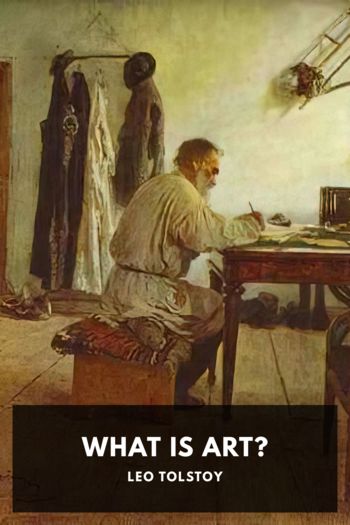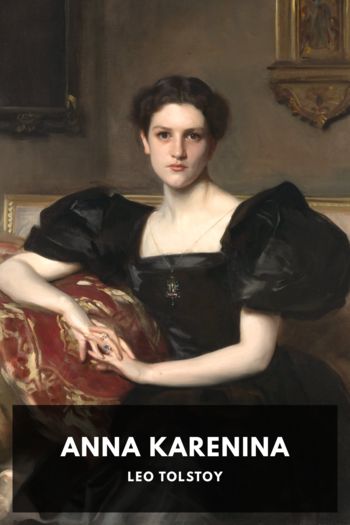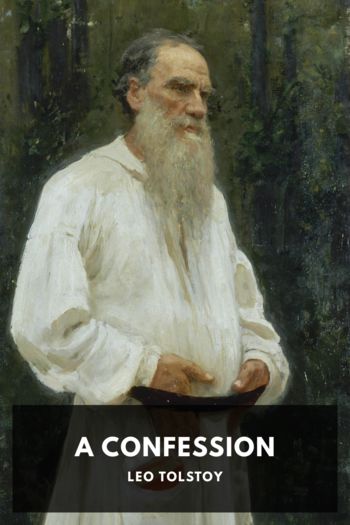What Is Art? by Leo Tolstoy (english readers .txt) 📕

- Author: Leo Tolstoy
Book online «What Is Art? by Leo Tolstoy (english readers .txt) 📕». Author Leo Tolstoy
I observed the audience present at this representation. The people who led the whole audience and gave the tone to it were those who had previously been hypnotised, and who again succumbed to the hypnotic influence to which they were accustomed. These hypnotised people, being in an abnormal condition, were perfectly enraptured. Moreover, all the art critics, who lack the capacity to be infected by art and therefore always especially prize works like Wagner’s opera where it is all an affair of the intellect, also, with much profundity, expressed their approval of a work affording such ample material for ratiocination. And following these two groups went that large city crowd (indifferent to art, with their capacity to be infected by it perverted and partly atrophied), headed by the princes, millionaires, and art patrons, who, like sorry harriers, keep close to those who most loudly and decidedly express their opinion.
“Oh yes, certainly! What poetry! Marvellous! Especially the birds!” “Yes, yes! I am quite vanquished!” exclaim these people, repeating in various tones what they have just heard from men whose opinion appears to them authoritative.
If some people do feel insulted by the absurdity and spuriousness of the whole thing, they are timidly silent, as sober men are timid and silent when surrounded by tipsy ones.
And thus, thanks to the masterly skill with which it counterfeits art while having nothing in common with it, a meaningless, coarse, spurious production finds acceptance all over the world, costs millions of roubles to produce, and assists more and more to pervert the taste of people of the upper classes and their conception of what is art.
XIVI know that most men—not only those considered clever, but even those who are very clever and capable of understanding most difficult scientific, mathematical or philosophic problems—can very seldom discern even the simplest and most obvious truth if it be such as to oblige them to admit the falsity of conclusions they have formed, perhaps with much difficulty—conclusions of which they are proud, which they have taught to others, and on which they have built their lives. And therefore I have little hope that what I adduce as to the perversion of art and taste in our society will be accepted or even seriously considered. Nevertheless, I must state fully the inevitable conclusion to which my investigation into the question of art has brought me. This investigation has brought me to the conviction that almost all that our society considers to be art, good art, and the whole of art, far from being real and good art, and the whole of art, is not even art at all, but only a counterfeit of it. This position, I know, will seem very strange and paradoxical; but if we once acknowledge art to be a human activity by means of which some people transmit their feelings to others (and not a service of Beauty, nor a manifestation of the Idea, and so forth), we shall inevitably have to admit this further conclusion also. If it is true that art is an activity by means of which one man having experienced a feeling intentionally transmits it to others, then we have inevitably to admit further, that of all that among us is termed the art of the upper classes—of all those novels, stories, dramas, comedies, pictures, sculptures, symphonies, operas, operettas, ballets, etc., which profess to be works of art—scarcely one in a hundred thousand proceeds from an emotion felt by its author, all the rest being but manufactured counterfeits of art in which borrowing, imitating, effects, and interestingness replace the contagion of feeling. That the proportion of real productions of art is to the counterfeits as one to some hundreds of thousands or even more, may be seen by the following calculation. I have read somewhere that the artist painters in Paris alone number 30,000; there will probably be as many in England, as many in Germany, and as many in Russia, Italy, and the smaller states combined. So that in all there will be in Europe, say, 120,000 painters; and there are probably as many musicians and as many literary artists. If these 360,000 individuals produce three works a year each (and many of them produce ten or more), then each year yields over a million so-called works of art. How many, then, must have been produced in the last ten years, and how many in the whole time since upper-class art broke off from the art of the whole people? Evidently millions. Yet who of all the connoisseurs of art has received impressions from all these pseudo works of art? Not to mention all the labouring classes who have no conception of these productions, even people of the upper classes cannot know one in a thousand of them all, and cannot remember those they have known. These works all appear under the guise of art, produce no impression on anyone (except when they serve as pastimes for the idle crowd of rich people), and vanish utterly.
In reply to this it is usually said that without this enormous number of unsuccessful attempts we should not have the real works of art. But such reasoning is as though a baker, in reply to a reproach that his bread was bad, were to say that if it were not for the hundreds of spoiled loaves there would not be any well-baked ones. It is true that where there is gold there is also much sand; but that can not serve as a reason for talking a lot of nonsense in order to say something wise.
We are surrounded by productions considered artistic. Thousands of verses, thousands





Comments (0)